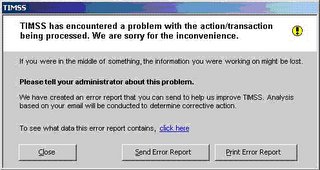
TAUG is the
TIMSS Annual User's Group meeting. This year's meeting is being held in Savannah, Ga. It is the 7th annual TAUG & the 6th one I've been to.
They are always held in great places (New Orleans, Miami, San Diego, San Antonio, Memphis, Tucson) and TMAR always puts on a fun event.
Not only is the location great, but the sessions are pretty good, too. I'll admit that when I was new to TIMSS I got a lot more out of the sessions, but after all I've been to, I still get little nuggets that help me in my day to day work. Last year I went to Susannah's open training session where I got to pick her brain for 3 hours; that alone was worth the registration fee.
TIMSSCare has presentations from previous TAUGs on their website if you want to see the kind of things that have been done in the past.
And it's always good to see where the product is going... I can't wait to see what's happening with version 7!
But for me, the best part of TAUG has to be the networking. Many of the TMAR staff attend TAUG and you not only get to put a face with the name, but you get to talk to them and pick their brains for
free.
And of course there are all the attendees: your counterparts at other organizations. I've made a lot of great contacts (and friends) at previous TAUGs. It's great to have someone to bounce ideas off of and meet people who do the same thing you do.
I hope to see you there and remember to bring lots of business cards!
Applies to: TIMSS5 & TIMSS 6
 You can obviously do this for multiple events, just change the message so you know which event gave the message box.
You can obviously do this for multiple events, just change the message so you know which event gave the message box.

